With so much conflicting information about healthy eating and what it looks like, the approach to diet change can be bewildering. One of the ways we might be able to ease this tension is to change our focus from what we eat to how we eat by adopting an eating philosophy that favours making a deeper connection to the body — a philosophy known as hara hachi bu.

Paying attention to the cues your body sends you is something we have seemingly forgotten how to do. Instead we have become reliant on others to tell us what to eat and in what quantities, ignoring the prompts our bodies give us every day about what it needs and how much.
Finding an approach to food and eating that helps you refocus your attention on the body can not only be liberating but much more healthful in the long run.
When it comes to connecting to the body, Eastern traditions often provide good examples of how you can tune in to and align the body and the mind. Tai chi, yoga and meditation are all ideologies and practices that have been embraced by Western cultures to help improve mental and physical health. In looking for a guide on how to reconnect with the art of eating and the body you are feeding, the practice of hara hachi bu can provide us with a centuries-old place to start.
The philosophy
A teaching attributed to Confucius, hara hachi bu is an instruction that advises us to eat only until we are 80 per cent full. Still practised in Japan on the island of Okinawa, it is credited with being the reason behind the longevity and good health of those who live there.
Indeed, Okinawans, who have always followed this principle, not only have the lowest levels of free radicals in their blood anywhere in the world but very low incidences of cardiovascular diseases, cancer and other age-related illnesses.
It’s a phenomenon that has interested scientists for decades and studies suggest this good health is less about what Okinawans eat and more about how much they eat, which highlights the most significant difference between hara hachi bu and our Western approach to eating: quantity.
Bu hikaye Eat Well dergisinin Issue #25 2019 sayısından alınmıştır.
Start your 7-day Magzter GOLD free trial to access thousands of curated premium stories, and 9,000+ magazines and newspapers.
Already a subscriber ? Giriş Yap
Bu hikaye Eat Well dergisinin Issue #25 2019 sayısından alınmıştır.
Start your 7-day Magzter GOLD free trial to access thousands of curated premium stories, and 9,000+ magazines and newspapers.
Already a subscriber? Giriş Yap
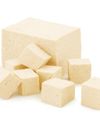
ARE YOU TO FU enough?
Love it or hate it, everyone has an opinion about tofu. Tofu is a very popular plant-based protein for vegans and vegetarians, but now this humble bean curd is starting to shine for meat lovers too as an alternative source of protein.

Sweet TRAYBAKES
Whether you want to feed a group of people or make a batch of treats for the week, traybaking is a no-fuss way to cook up something sweet and easy that will please everyone. Your family and friends will love you when you offer them some of our: cinnamon scrolls; fruity chocolate; espresso brownies; lemon & coconut slice; or ginger cake with brown butter frosting.

ROLL UP
When you roll food, whether in Lebanese bread, a thin pancake or whatever you choose, you can create a parcel of nutrition that is perfectly suited to your own tastes and needs. Here are some roll-up recipes that will suit every occasion including: mango, snow pea, & sprout rice paper rolls; oat crepes with coconut yoghurt & mixed berries; or beef meatball & tzatziki flatbreads.
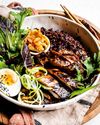
RICE BOWL Lunches
If you are working from home, or even enjoying your weekend, and lunchtime rolls around but you have no plans for lunch, then a rice bowl is an ideal saviour.
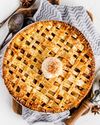
PLANT-BASED PIES
Pies are a piece of gastronomic brilliance: a filling with a case and lid you can eat is food genius. The first pies date back to Egyptian times and there is a recipe for chicken pie that was carved into stone more than 4000 years ago. For millennia, however, the pie casing was mostly used to cook the filling, but for around 500 years or more we have been eating the pie crust too.

20 FOOD CRAVING HACKS
Decipher the deeper causes of your cravings and discover tricks to curtail them.

Eggplant (Solanum melongena L)
Eggplant is a wonderful option for vegans and vegetarians, extremely nutritious and highly versatile in the kitchen.
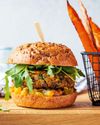
5 PANTRY SAVIOURS
Whether you're cooking a simple breakfast or something more exotic, here are five pantry food staples you should have on hand to cook plenty of delicious meals in the comfort of your own home.
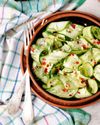
Cucumber (Cucumis sativus)
Cucumbers are delicious fresh but they also offer plenty more options in the kitchen.

Our Chefs
Meet the chefs who bring this issue's recipes to you: Lisa Guy, Georgia Harding, Lee Holmes, Sammy Jones, Raquel Neofit, Naomi Sherman and Ames Starr.